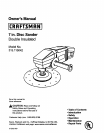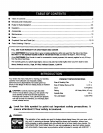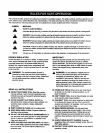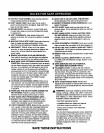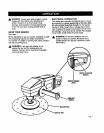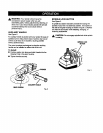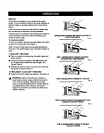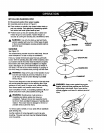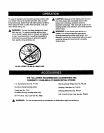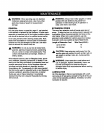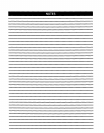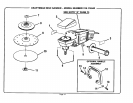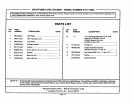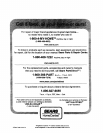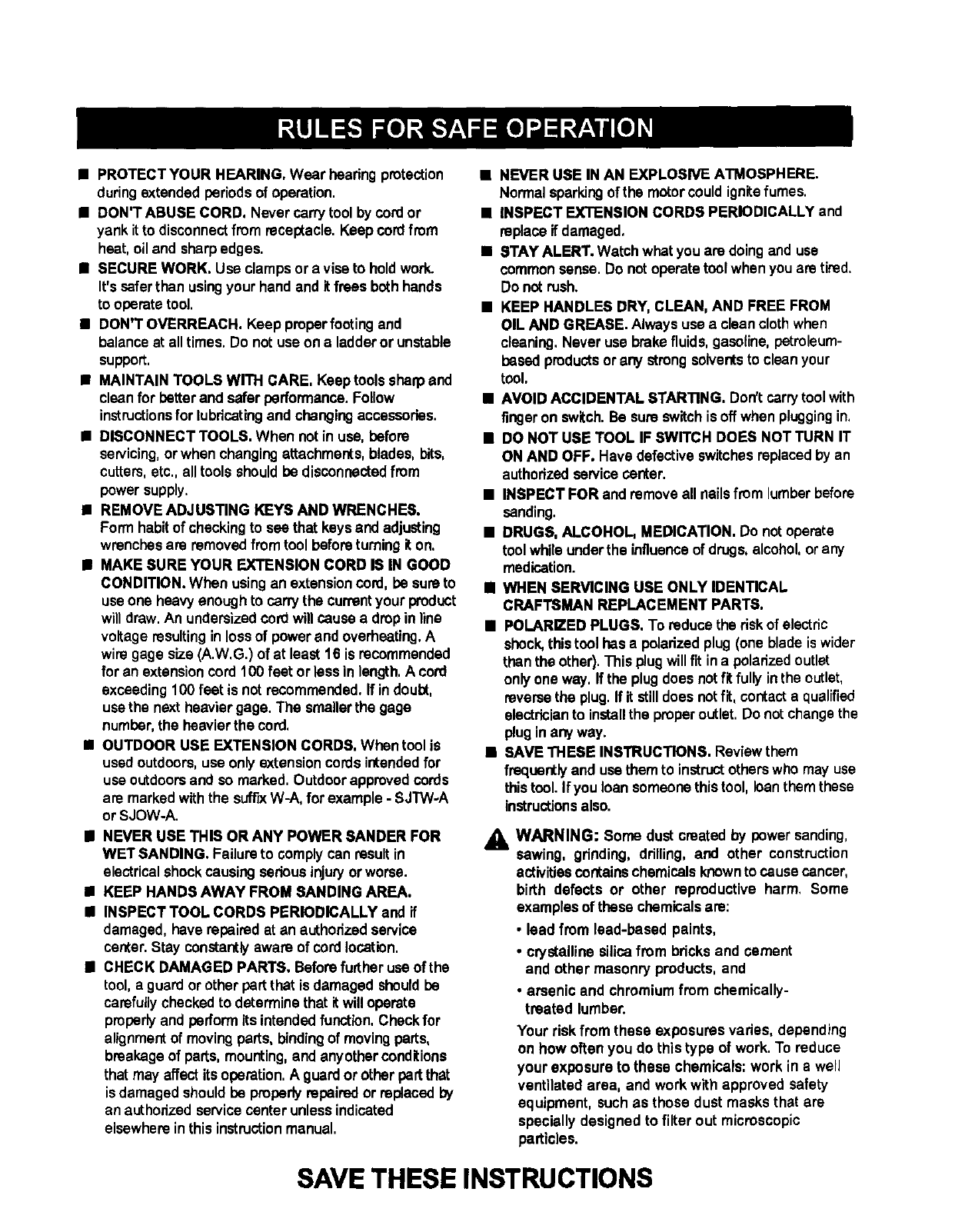
• PROTECTYOUR HEARING, Wear haaring protection
duringextended periodsofoperation.
• DON'T ABUSE CORD. Never cam/tool by cordor
yank itto disconnectfrom receptacle. Keep cord from
heat,oil and sharp edges,
B SECURE WORK. Use clampsor a viseto holdwork.
It'ssaferthan usingyour hand and itfrees both hands
to operate tool.
• DON'T OVERREACH. Keepproperfooting and
balance at all times, Do not use on a ladderor unstable
support,
• MAINTAIN TOOLS WITH CARE. Keep tools sharpand
clean for Petterand safer performance. Follow
instructionsfor lubricatingand changingaccessories.
• DISCONNECT TOOLS. When notin use, before
servicing,or when changingattachments,blades, bits,
cutters,etc., all toolsshouldbe disconnectedfrom
power supply.
• REMOVE ADJUSTING KEYS AND WRENCHES.
Form habitofcheckingto see that keys and adjusting
wrenches are removed from tool beforeturningit on.
• MAKE SURE YOUR EXTENSION CORD IS IN GOOD
CONDITION. When using an extensioncord, be sureto
use one heavy enough to carrythe currentyour product
will draw. An undersizedcord will cause a dropin line
voltage resultinginlossof power and overheating,A
wire gage size (A.W,G.) of at least 16 is recommended
for an extensioncord 100 feet or less in length,A cord
exceeding10Ofeat is not recommended.If indoubt,
use the next heavier gage. The smallerthe gage
number,the heavierthe cord,
= OUTDOOR USE EXTENSION CORDS, Whentool is
used outdoors,use onlyextensioncords intendedfor
use outdoorsand so marked, Outdoorapprovedcords
are markedwiththe suffixW-A, for example - SJ'n/V-A
or SJOW-A,
B NEVER USE THIS OR ANY POWER SANDER FOR
WET SANDING, Failureto comply can result in
electricalshockcausing seriousinjuryor worse.
• KEEP HANDS AWAY FRO• SANDING AREA.
• INSPECT TOOL CORDS PERIODICALLY and if
damaged, have repaired at an authorizedservice
center. Stay constantlyaware of cord location.
B CHECK DAMAGED PARTS. Before furtheruse of the
tool, a guard or otherpart that isdamaged shouldbe
carefullycheckedto determinethat itwilloperate
properlyand peflorm its intended function,Chackfor
alignmentof movingparts, bindingofmovingparts,
breakage of parts, mounting,and anyother conditions
that may affect itsoperation.A guardor other partthat
is damaged shouldbe preperlyrepairedor replacedby
an authonzedservicecenter unlessindicated
elsewhere inthis instructionmanual.
• NEVER USE IN AN EXPLOSIVE ATMOSPHERE.
Normalsparkingof the motorcould ignitefumes.
• INSPECT EXTENSION CORDS PERIODICALLY and
replace if damaged,
• STAY ALERT. Watch what you are doingand use
commonsense. Do notoperate tool when you are tired.
Do not rush.
• KEEP HANDLES DRY, CLEAN, AND FREE FRO•
OIL AND GREASE. Always use a cleanclothwhen
cleaning, Never use brakefluids, gasoline, petroleum-
based productsor any strongsolventstoclean your
tool.
• AVOID ACCIDENTAL STARTING. Don'tcarrytool with
fingeron switch.Be sureswitch isoff when pluggingin,
• DO NOT USE TOOL IF SWITCH DOES NOTTURN IT
ON AND OFF. Have defectiveswitchesreplacedbyan
authorizedservice canter.
• INSPECT FOR and removeall nailsfrom lumberbefore
sanding.
• DRUGS, ALGOHOI., MEDICATION. Do notoperate
tool while underthe influenceofdrugs,alcohol,orany
medication.
l WHEN SERVICING USE ONLY IDENTICAL
CRAFTSMAN REPLACEMENT PARTS.
• POLAR_ED PLUGS. To reducethe riskof electric
shock,thistool has a polarizedplug (one bladeiswider
than the other). Thisplugwillfit in a polarized outlet
only one way, If the plugdoes not fit fully inthe outlet,
reversethe plug.If it still does notfit, contact a qualified
electricianto installthe properoutlet. Do notchange the
pluginany way.
• SAVE THESE INSTRUCTIONS. Reviewthem
frequentlyand use them to instructothers who may use
thistool.If you loan someonethis tool, loanthem these
instructionsalso.
A
WARNING: Some dust created by power sanding,
sawing, grinding, drilling, and other construction
activities contains chemicalsknowntocause cancer,
birth defects or other reproductive harm. Some
examplesof these chemicalsare:
• lead from lead-based paints,
• crystalline silica from bricks and cement
and other masonry products, and
• arsenic and chromium from chemically-
treated lumber.
Your risk from these exposures varies, depending
on how often you do this type of work. To reduce
your exposure to these chemicals: work in a well
ventilated area, and work with approved safety
equipment, such as those dust masks that are
specially designed to filter out microscopic
particles.
SAVE THESE INSTRUCTIONS



